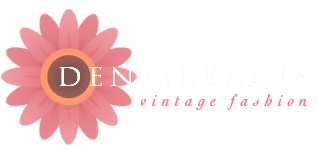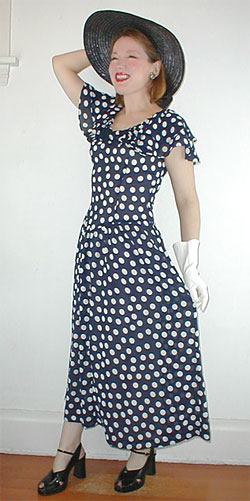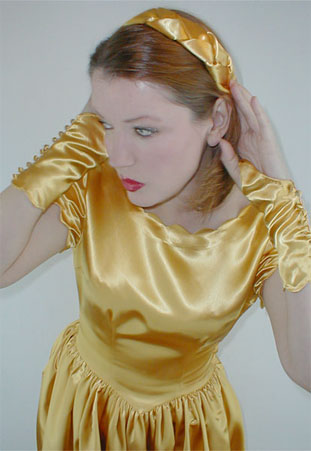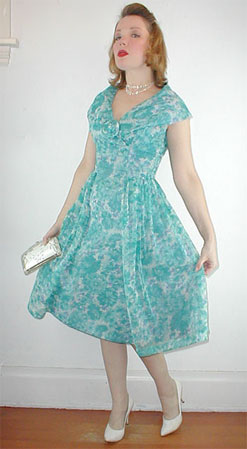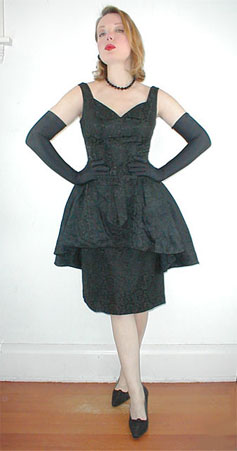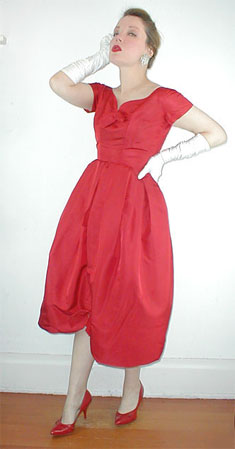Can you believe it? I'm a musician, and I'm selling vintage clothing and accessories that have music prints/themes! These are hard to come by, I'll tell you, as I have been searching for over a year!
Twirl on by my eBay store by way of my latest theme, Music Box, to find some great items.
Click image below to view, sound up.
Here are a couple of items up right at this moment:
I am really honored and touched by a portion of a personal web page devoted to me here.
Mary Beth, who wrote this, is someone I met through sales on eBay. I do often meet wonderful people, and am so gratified by their kind comments about my work. I am so grateful for what Mary Beth has written because it really helped me realize that I am offering something positive to people. I need that.
Mary Beth is struggling with a disease that I have just barely begun to understand. From what I can tell, she is battling just to live, at the same time living a gloriously positive, meaningful, beautiful life. I deeply appreciate knowing that too, because sometimes I struggle to get by, in various ways. If she can do it, I'll try!
She wrote about me as an inspiration to her, and I can only begin to say what an inspiration she is to me.
It really is a privilege to dip into a woman's closets with the woman right there to talk to. Juana is--at what looks from the history of her clothing--to be about 80, but her actual appearance is of someone at least a decade younger. She and her husband were planning a move into a retirement home when I met her, and her height and fine-featured beauty were so unusual that I pried and found out that she had worked as a model for one of Spokane's department stores, The Bon Marche.
I could tell that she had previously let go of much of her clothing from before the late 60s, but there were a few choice items dating back to the early 40s. I love the outgoing taste and expression she found in her clothing! Here is a sampling:
Early 40s pajama top
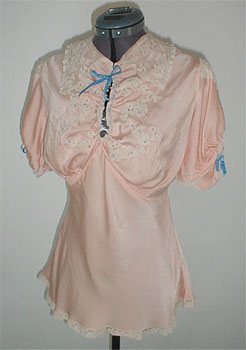
Early 40s suit
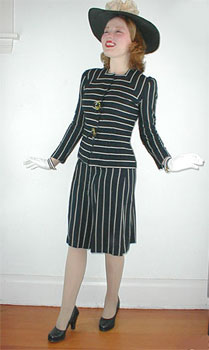
Hand-painted Mexican skirt
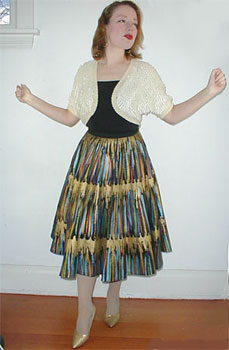
Plastic and rhinestone shoes
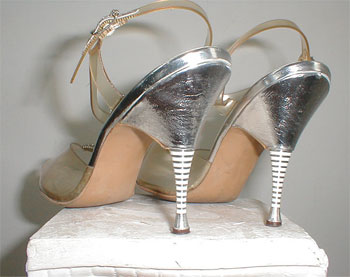
Miss Egypt
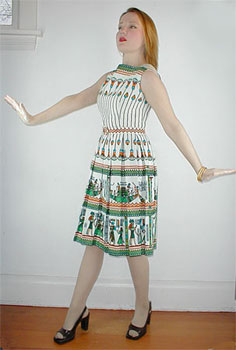
Veil hat
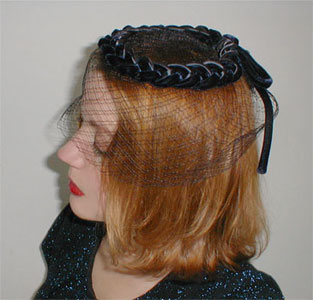
Herbert Sondheim
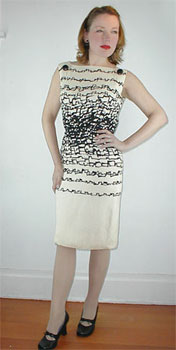
Dior

Wool suit
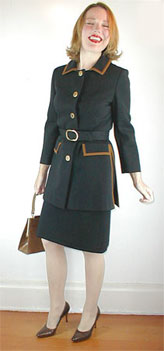
60s suede
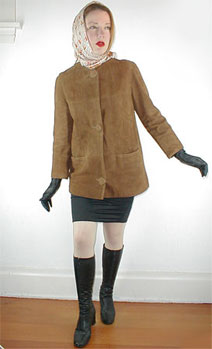
Green feather toque
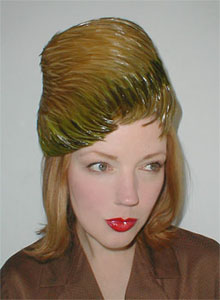
Pauline Trigere
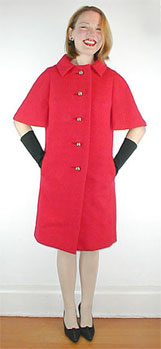
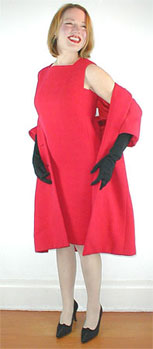
Teal Traina
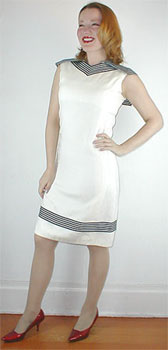
Yellow feather toque
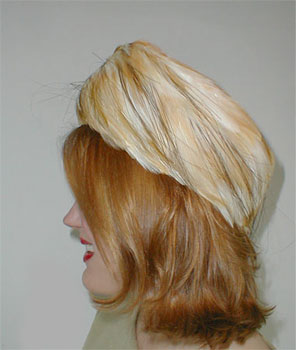
Norman Kaplan
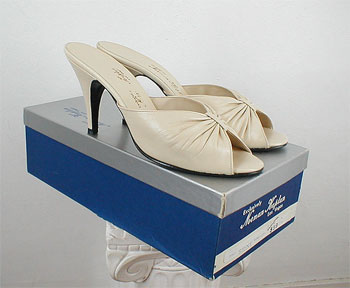
Icing pink leather Lilli Ann
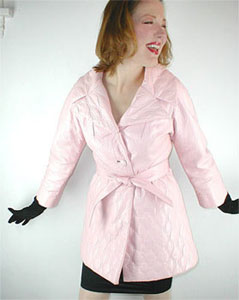
Lilli Ann knit suit
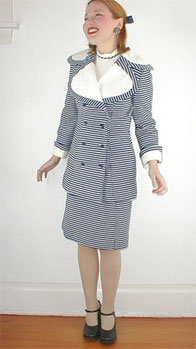
Another 60s Lilli Ann
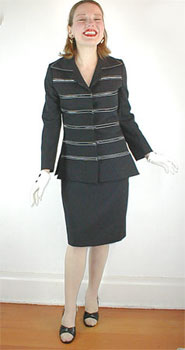
Easter bonnet extraordinaire
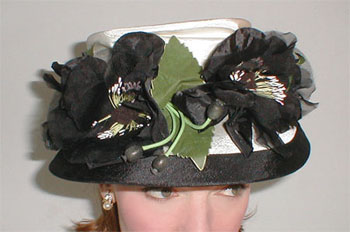
Jane Andre
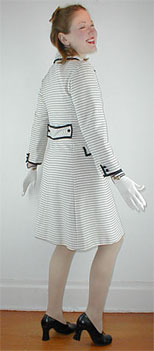
Jane Andre with city names embroidered
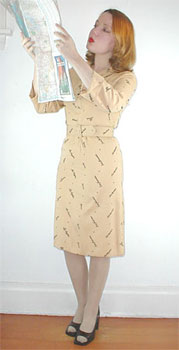
Rinaldi party shoes
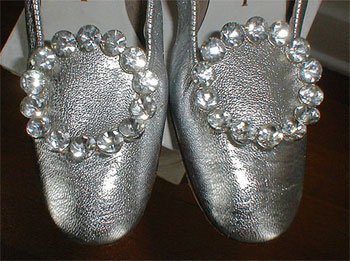
DeWeese swimsuit
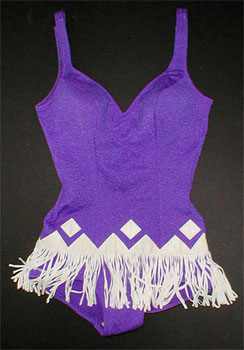
Alfred Shaheen
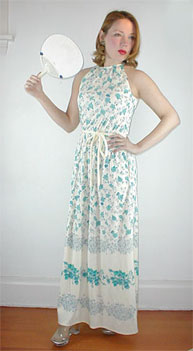
White lace
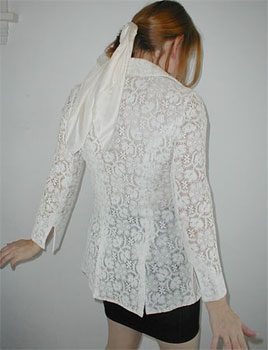
White wicker
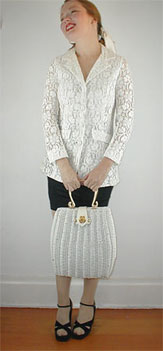
Young Edwardian
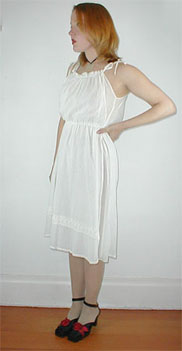
This was written by my niece, Flora Wilds, who is in 8th grade. Love this girl, and love the way she thinks!
Attack of the Shoes
Click-clack, click-clack
Can you hear them talking?
Click-clack, click-clack
All the shoes are walking
Sitting in a cardboard box
In the stores all day
Waiting for some lucky buyer
To purchase and take them away
Stilettos, pumps, boots, and flats
Each have different personalities
Dressy, sporty, new, and old
Living in their own realities
Designer, vintage, men's, and women's
Plain, bold, and polka-dotted
Sitting lonely on a shelf
Anticipating being spotted
But when they are purchased and taken home
Off the shelf to be free
Worn by their owners (a shoes greatest joy)
So they, too, can click-clack happily
Some shoes smile, some frown, some have a pointy nose
Some like to show five white teeth (or toes)
Some shoes are short, others are tall
And to each other they endlessly call
In voices big and small:
"Hey! Look at me!
I'm the most beautiful shoe!
I'm shiny, I'm red, and I'm new!
I click and I clack
And I'm on the attack!
For I am the prettiest shoe!
Shoes can be vengeful and ever so tight
Yet some can be comfortable and free
But no matter what, they love to be worn
By you, and by her, and by me
So be kind to your shoes and wear them alot
Because they have feelings, too
Keep your feet clean (and don't ever smell)
Because they're the ones carrying you!
Which brings me to myself. The fact is that I find it so very hard to move on to the next thing always. I still keep books mostly by pen on paper, and when I do creative writing it is always by hand. I work online, and know how to type, and I'm very glad for those little steps I've taken.
Recently I was exposed to the concept of Google AdWords, and I read of people striving to create the perfect verbiage to be picked up on Google, to be almighty found in the vast sea of information and commerce.
Today, as a Homo sapien that probably has a drop of Neanderthal blood, I want to laud those who have not achieved among the first pages of Google in vintage clothing. As a matter of fact, I'm looking at page 75 in the search "vintage clothing," and on it are some fine things! I have purchased an item from Frock of Ages and I can say that whenever I check back, there is something sensational on sale. Look at the little black dresses by Suzy Perette, for instance.
On page 75 I see a piece about Xtabay, a wonderful shop I've visited in Portland. Not only is it a great shop with an interesting name, but the owner is a smart and sensitive person who has an amazing eye for what works on people.
Then there's Marian's Vintage Vanities Clothing, and who wouldn't want this 50s halter dress for $35?
I don't really know my point...maybe just that holding still doesn't necessarily mean one is worthless. For my sake, I hope not.
Eight years ago yesterday I started working as a vintage clothing dealer. Here is the very first item I sold on eBay:
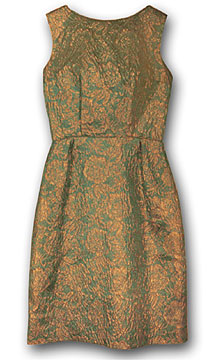
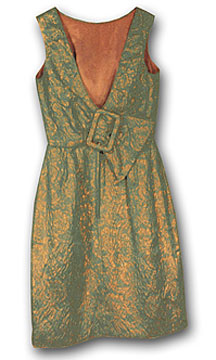
I titled the photo "dress." I think the dress sold for $14.00. With every single communication I had with the buyer, I double and triple checked spellings and addition...I was so unused to selling anything to anyone! She liked the dress, and I was hooked!!
I must honestly say I love what I do, working with vintage clothing, and most of all, meeting the great buyers from all over the world who keep me in business. Nothing could make me more happy and proud than the fact that almost half (49.1%) my eBay feedback is from returning customers.
If you haven't visited my web site for awhile, I invite you to I look forward to meeting you, and saying hello to my old friends!
Anne Fogarty
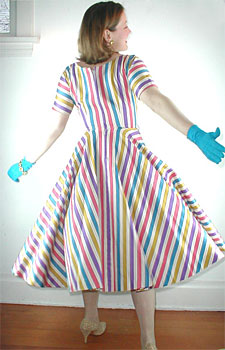
Fringed-skirt late 40s suit from Bernard's, Spokane

Adele Simpson
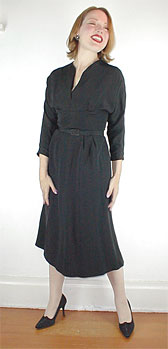
Claire McCardell
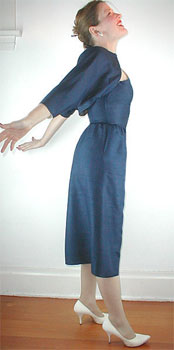
Another Claire McCardell
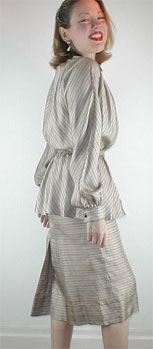
Ceil Chapman
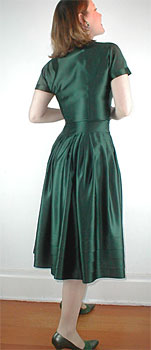
Louella Ballerino for Jantzen
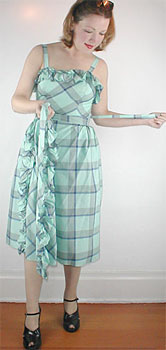
Louella Ballerino for Jantzen...in green
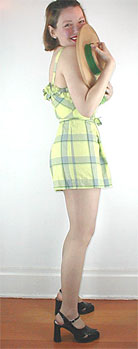
Hollywood Sport Life
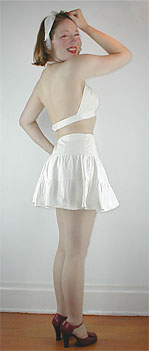
Irish linen and silk
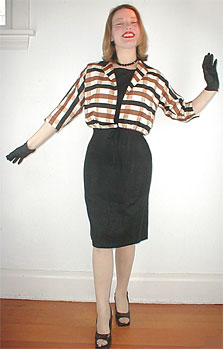
L'Aiglon

No-label 40s
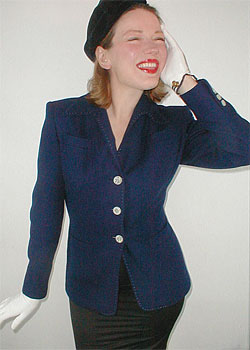
Donald Brooks

Nani, Hawaii
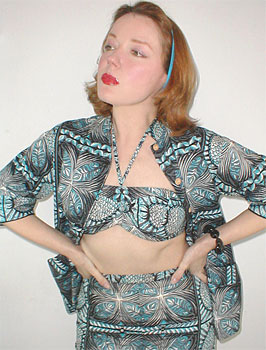
Hand-embroidered Mexican
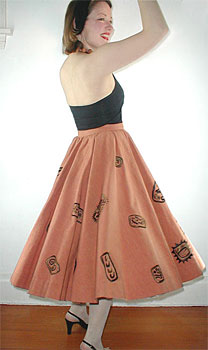
Morton Bregman
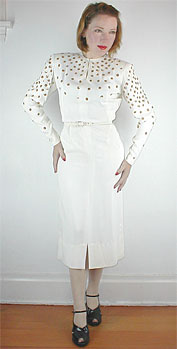
Pat Hartley
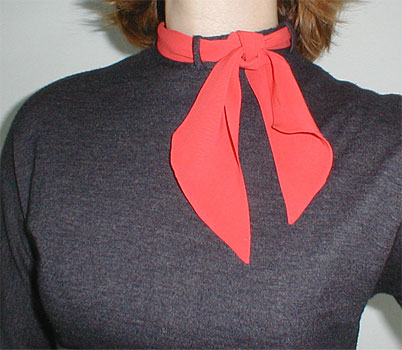
Marguerite Rubel
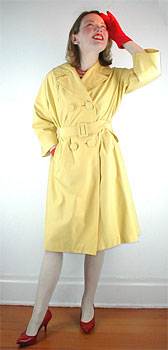
No-label but stunning 40s strapless
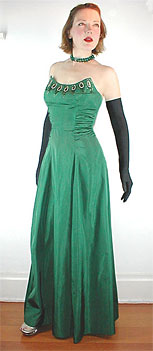
Edith Small
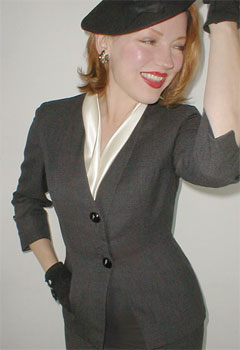
B.H. Wragge
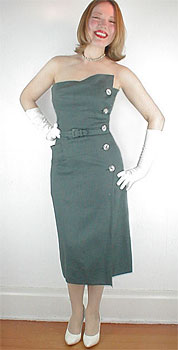
Forstmann
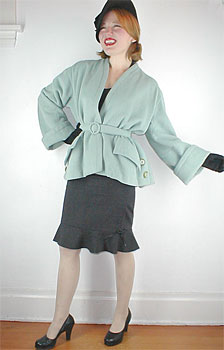
Mustard wool unlabeled
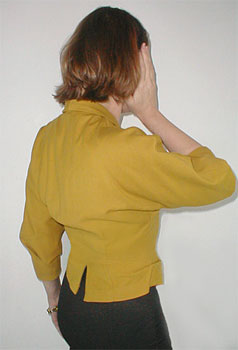
Handmade taffeta
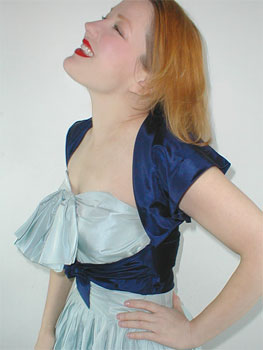
Malbe
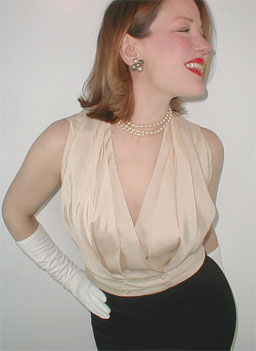
David Crystal
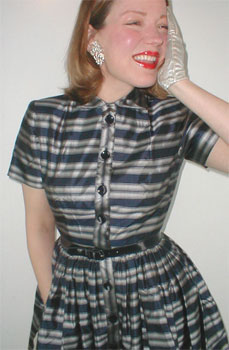
Frederick & Nelson, Seattle
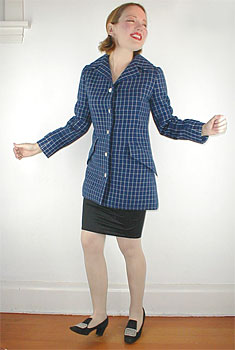
Unlabeled 40s wrap top
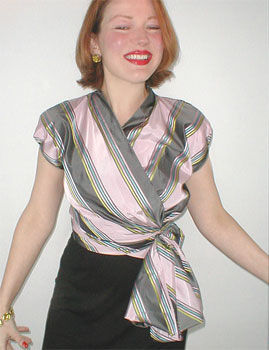
Red linen and wool
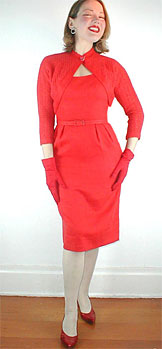
Miriam Gross
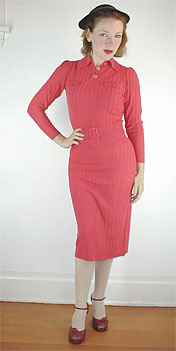
Hand-embroidered Mexican
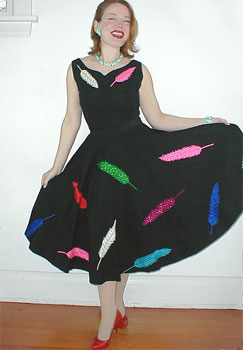
Bernard's, Spokane

No label 40s jacket
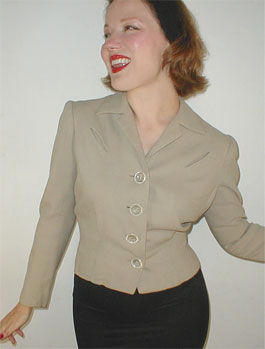
Harvey Berin Designed by Karen Starck

Unlabeled
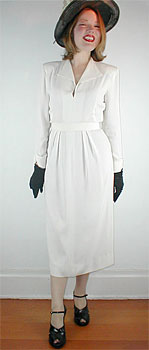
Then there are the two things I haven't been able to part with, an unlabeled 40s outfit...
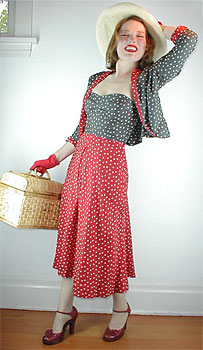
...and a Patricia Lester silk outfit from the 70s
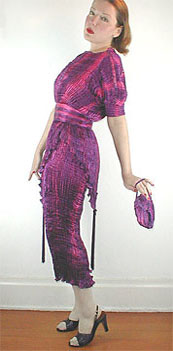
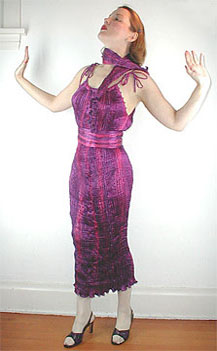
Of Helen South Alexander's many gifts to Spokane, the swans of Manito Park are perhaps her most manifest legacy.
They were given to the city in 1968 by her late husband, the longtime Spokane civic leader Philip Alexander. But it was Helen who became the ardent supporter of the graceful white birds, remaining a lifelong patron of a group called Manito Park Swans.
In fact, two of the original cygnets that swam at the pond were named in the couple's honor: Philip of Macedon and Helen of Troy.
In many ways, Helen South Alexander was a lot like the swans she loved: A woman of style and elegance, she walked through life with a majestic air, said those who knew her. She beautified her surroundings not only through her work as an interior designer, but also as a patron of the arts.
A longtime Spokane resident, Alexander died last Friday. She never disclosed her age and was adamant before her death that it didn't appear in her obituary.
Mrs. Alexander, I salute you...nay, I worship you. I actually met Mrs. Alexander in my capacity as Principal Horn of the Spokane Symphony, while she was in her long-time capacity as patron of the Symphony, and of all arts in Spokane. She was beautiful, ageless, and impeccably gracious, always distinctive in her dress, however I had no idea of the contents of her closets until the auction in which her clothing was sold, some months after her death in 2004.
At this point it has been a couple of years since that auction, and more than ever I feel that it was a once-in-a-lifetime experience. There were 3,000 to 4,000 clothing and accessory items of the most glorious nature, chosen with a designer's eye and in almost exclusively ideal condition.
Mrs. Alexander's second husband was chairman of one of Spokane's big department stores, and she had ultimate access to the best clothing of the time even though she was living in relative isolation in Spokane. That alone would not have guided her taste...she was a prolific artist of dress.
While wearing the most beautiful and forward-thinking clothing as a young woman in the 30s and 40s, it was the 50s through present at this auction that most impressed. it would be hard to name an important designer from the 50s, 60s, 70s or 80s that was not represented in Mrs. Alexander's wardrobe...at least several times. There was an entire table of Ferragamo pumps, a rack just of 70s Diane von Furstenburg wrap dresses, some with tags. I yearned for a quintessentially Mod red coat by Pierre Cardin, an unused, iconic Bonnie Cashin coat, a WWII-era Red Cross hourglass suit/uniform with all kinds of interesting pins and patches. Frankly, I yearned for everything from a 30s velvet gown to an ornate Christian Lacroix suit from the 80s...in short, for everything!
An early 1970s Oscar de la Renta hand-painted black leather coat was probably the biggest sale of the auction, at $6,000. One buyer--reputedly (my friend quizzed him) with stores in Los Angeles, London and somewhere in Asia--spent voluptuously, as if there were no limits with items of this quality. There were buyers from many places, all there just for vintage clothing from one woman's highly distinctive closets.
Next time: A sampling of what I was able to take home from this great collection.
If an item was created by expert and well-paid craftspeople, then the item is likely worth the cost. I encourage those who can to pay the full price for high quality clothing, made by well-paid workers creating beautiful fashions...yes! However, if you can, stand up to the high prices for ordinary clothing by searching for extraordinary vintage. Never before in the last 30 years has vintage represented a greater quality-for-the-price ratio. Walmart does not have real clothing, and Target has clothing nicely designed for hangers. Those low prices reflect items of no more value than Kleenex. Actually less, as these items will not serve their purpose for what has been considered a normal lifespan.
Clothing should not be as disposable as Kleenex!
Stuffed olive Mod
50s Cinderella
Witchy, witchy, witchy!
Meow-wow Levines
Go-go Levines
Tie me up (in your choice of lacing colors!)
I do!
Sauvage
Silver wear
Silver wear 2
Silver wear from the 30s
Granny goes to Woodstock
Flat out fun
Indie-rella
Not-so-shy baby blue
Shoe shine
Shoe shine that's lasted since the 40s
Conquistador of the pavement
On a pedestal
Kept in stitches
You will still find a number of items in my eBay Store benefiting this great cause. Have a look, spread the word, do your own best thing for the world.
Happy New Year to all and may it be a more peaceful, loving, happy year for everyone everywhere.
During the summer I went to an estate sale where I found, among other things, a vintage globe, for next to nothing. I bought it, not entirely sure why. It sits in my living room, as there are not many other places it will fit in my place. One day, feeling down, I happened to look up at the globe, and Africa was staring back at me. It doesn't take much to know that I am luckier than most people in Africa right now and at that moment, looking at the globe, I felt very foolish feeling any sorrow for myself. I am extremely fortunate next to most people on Earth.
In December I always like to think of a way to make a difference for someone less fortunate, and with my globe in mind, I am so happy to have discovered Women for Women International. I'm so impressed with their hands-on work to help women (and through women, all of society) in war-ravaged parts of the world. Please read my holiday message about this great organization and my reasons for wanting to help.
All through the month I will be offering a number of items in my eBay store and auctions with 100% of the final sale price going to Women for Women International. I would be so glad if you would come check out my offerings at denisebrain.
I started selling vintage clothing on eBay among a fabulously wide array of great sellers, all with great items, fine feedback and excellent auction listings. I knew at that time that I couldn't really compare in the depth of my business, the depth of my knowledge, or the depth of my inventory. Not a model in age, size, looks or experience, I decided to model some of the vintage clothing I was selling. I sometimes took 60 photos per one reasonable finished product in 2000. The main reason for trying this was to distinguish myself from other sellers. I wanted to advocate--in words and pictures--for my offerings.
A couple of early modeling efforts:
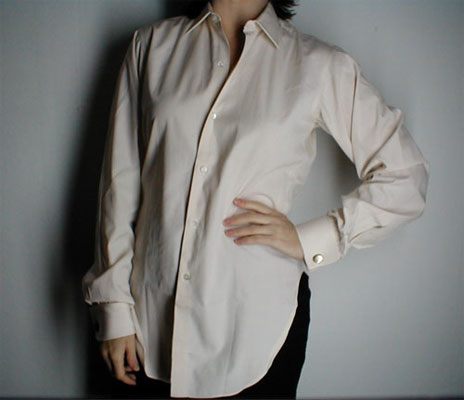
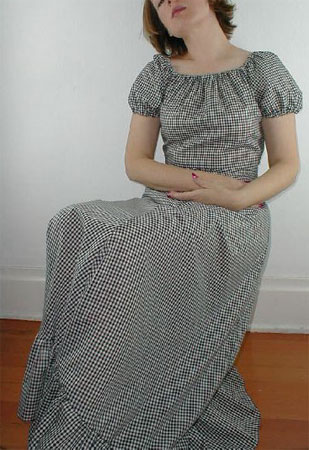
After awhile I started to be known for doing my own modeling and I am still the same non-model in terms of age, size and looks! Oh, actually I'm even older! However, I am gaining experience. When someone says to me that she knows someone who is "very cute and would make a great model" I feel skeptical until I see her "act" because to me it is all about acting a part. I do smile in real life, but nothing like the unrelenting joy I often portray in photos. This isn't real life after all, but a glorified fragment of a better, perhaps imagined past. I love old fashion magazines, with their intriguing photography and modeling, not to mention the clothing. I want to convey the flavor of the happy, healthy look you often find in vintage fashion spreads.
Once someone posted a message about me, that I "invite everyone else in for the fun, instead of trying to be cooler than [my] buyers." Nothing could make me happier than that statement, because I only want others to feel they could enjoy the clothing as much as I do!
There are a number of tests, some along the lines of folklore (dampening and creasing a fabric to see how it behaves) and some more scientific (exposing a fabric to certain chemicals and examining it under a microscope), but by far the most accessible test is burning.
One web offering, Ditzy Prints Fiber Burn Chart is a great resource. You should know that burning fibers takes practice, and you must start with a little caution. You should burn over a sink or bucket so that if you get what seems like a fabric inferno you can ditch! Most necessary is a tweezers to hold the little fabric swatch, and a lighter. If you burn matches of any sort you will pick up the scent of burning paper or wood, throwing you off for discerning the burning fabric's odor.
If you are really serious about learning how a fiber burns, I recommend taking known fabric samples and examining how they smell and behave while burning, and look, feel and smell once burned.
Many fabrics are blends and will have characteristics of more than one fiber when burned. If you are lucky, the fibers are distinct in the fabric, so that you can separate the weft from the warp and discover the content of each fiber.
One giveaway is acetate, which is the only fiber that dissolves when dampened with acetone (i.e. nail polish remover).
To do a burn test, do your best to find as big a swatch as possible without damaging or conspicuous loss to a garment. Even a few threads are "readable" once you get good at this, but a piece of about 1" X 1/4" is a minimum necessity if you are just getting started. Hold one end of the fabric with the tweezers and expose the other end to the flame of a lighter. Notice if the fabric readily burns or takes some effort to light. Also, note if the fire burns out or continues until all the fabric is burned. Smell the burning fabric.
Then, once the fire is out, notice whether the remains are black or grey, and feel to decide if is harder (bead-like) or soft (ash-like). On the fiber burn chart all these elements will help you narrow the choices.
Your senses also will help determine a fabric's fiber content without burning, given a chance to learn. With experience a silk, wool, rayon, polyester or acetate are discernible just by look and feel...but the details of their look and feel are so much harder to describe online.
I wish everyone who cared to learn about fabrics could have a mentor lead them. From what little I know, a knowledgeable person and a guided experience with fabrics makes a very complex project so much easier and memorable. If you have a chance, be taught first hand!
I have a long way to go, but I have positively identified examples of most of these fabrics, and I mean to grow the list and swatch samples. I hope that even the descriptions help others.
NETS
Illusion - Very fine, sheer net
Point d'esprit - Net with dots scattered all over
Tulle - Fine net with a hexagonal mesh.
LIGHTEST, OPEN WEAVE OR SHEER FABRICS
Crepe de chine - Plain weave with fine crepe effect
Gauze - Thin, sheer open weave of plain or leno weave
Georgette - Sheer plain weave with a fine crepe surface
Handkerchief linen - Sheer linen
Mousseline - Broad classification of lightweight, sheer crisp fabrics
Organdy - Sheer, plain weave stiffened lawn
Organza - Transparent, crisp plain weave
Voile - Sheer plain weave with crisp, wiry hand
FINE, LIGHT FABRICS
Batiste - Plain weave, with subtle lengthwise streaks
Cambric - Soft plain weave, slight luster
Challis - Soft plain weave, often printed w/ small florals
Charmeuse - Soft, drapey, smooth, semi-lustrous satin face, dull back
Crepe-back satin - Reversible satin weave, smooth & lustrous on one side, crepe on other
Gabardine - Twill weave w/ distinct rib
Lawn -Fine, plain weave, relatively sheer. Close construction
Percale - Plain weave, firm, balanced construction
Sateen - Cotton in satin weave
Surah - Silk or silky manufactured fabric in twill weave. Soft, lustrous
COARSER, HEAVIER FABRICS
Buckram - Plain weave, coarse, open, heavily sized, used as a stiffener interfacing
Cavalry twill - Strong, rugged, pronounced double twill at 63° angle
Cheviot - Hairy nap wool or worsted, rough surface, fulled. Plain or twill weaves
Chino - Twilled mercerized cotton
Denim - Right-hand twill weave, colored warp, white filling (compare to drill)
Drill - Resembles denim, but left-hand twill
Duck - Plain weave, light canvas
Homespun - Plain weave, course, uneven yarns, similar to tweed
Hopsacking - Same as burlap. Basket weave, coarse, loosely woven
Lodencloth - Coarse wool coating fabric woven in the Tyrols w/ natural water repellancy
Melton - Plain weave, completely smooth, short nap, at least partly wool
Muslin - Firm, plain weave cotton; broad category from sheer to heavyweight
Serge - Most commonly twilled worsted suiting dyed navy blue
Whipcord - Twilled rugged fabric w/ wiry hand
PILES AND TREATED FABRICS
Burn-out fabric - Made w/ 2 different yarns w/ pattern made by destroying one of the yarns in a printing process which uses chemicals instead of color.
Crushed velvet - Velvet processed to have irregular surface
Panne velvet - Flattened pile velvet
Plush - Surface longer than velvet, less closely woven
Velvet - Short cut warp pile fabric
PATTERNED OR PUCKERED TEXTURED FABRICS
Crepe - Wrinkled or grained surface effect
Embossed fabric - Raised design made by passing cloth through hot, engraved rollers
Matelassé - Puckered, quilted, waded effect
Plissé - Puckered stripes made by applying caustic soda
Seersucker - Puckered stripes made by weaving tension variations
SLUBBY TEXTURED FABRICS
Butcher cloth - Linen like, strong, heavy, plain weave
Donegal tweed - Plain or twill weave medium to heavy wool with colored slubbing
Doupioni silk - Irregular, rough silk reeled from double cocoons
Pongee - Plain weave, light to medium-weight irregular silk, often natural ecru color
Shantung - Rough, plain weave silk, heavier than pongee
VERY TEXTURED FABRICS
Bouclé - Woven or knit fabric using rough, curly, knotted, fancy yarn
Ratiné - Plain weave, loosely constructed fabric using curly, knotty fancy ratiné yarn
HORIZONTALLY RIBBED FABRICS
Bengaline - Plain weave, filling courser than warp, but more warp yarns used, covering picks
Broadcloth - Unbalanced plain weave, finer rib than poplin
Faille - Plain weave, like grosgrain only flatter rib
Grosgrain - Firm, closely woven plain weave ribbed fabric or ribbon
Ottoman - Plain weave, cords larger & rounder than faille or bengaline
Poplin - Subtle but noticeable rib warp plain weave fabric, more rib than broadcloath
Rep - Plain weave, close spaced narrow ribs, less than bengaline, more than poplin
Taffeta - Broad category of plain weave, fine, smooth, crisp fabrics, usually w/ fine cross rib
VERTICALLY RIBBED FABRICS
Bedford cord - Heavy, plain weave corded fabric
Corduroy - Pile ribbed
Pinwale corduroy - Finely ribbed
Piqué - Light bedford cord, or also in fancy patterns (i.e. bird..s eye)
FABRICS WITH SPECIAL FINISHES
Brushed fabric - Softened feel from wire brushing process
Chintz - Plain weave cotton or cotton blend w/ glaze treatment
Flannel - Light to medium weight plain or twill weave fabric, slightly napped
Moiré - ..Watered.. finishing process, usually applied to ribbed fabric
Polished cotton - Luster from satin weave, or smoothing roller finish
Suede cloth - Woven or knit fabric finished to resemble suede
Sueded silk - Soft nap finish silk
PRINTED PATTERN FABRICS
Calico - Plain weave cotton or blend with small, busy, printed pattern
Foulard - Lustrous twill w/ small printed design on plain ground
Toile de jouy - Floral or scenic designs, classic motifs finely detailed
WOVEN PATTERN FABRICS
Brocade - Rich, heavy jacquard-woven fabric w/ raised patterns emphasized by contrasting surfaces or colors (see jacquard, damask)
Chambray - Plain weave w/ colored warp, white filling
Damask - Similar to brocade, but flatter
Dobby weave - Specific, small, geometric figures in fabric woven w/ dobby loom
Gingham - Plain weave, even check plaid
Heather effect - Vari-colored effect from blended woolen yarns, often greens, browns
Houndstooth check - Twill woven in characteristic pattern
Jacquard - System of weaving capable of producing complex and large woven designs
Oatmeal weave - Uneven weave in small repeat which produces speckled surface
Ombré (woven or printed) - Gradual shading from light to dark, or hue to hue
Shadow stripe weave - Indistinct stripes produced by using different yarns, in a plain weave
Sharkskin - Most often blk & white in close plain weave worsteds
Ticking - Strong, durable, close woven in any basic weave, characteristic stripe
OTHER PATTERNED FABRICS
Batik - Wax-resist dying
Birds eye - Small indentations
Dotted swiss - Can be woven or flocked dots on plain weave
Eyelet - Edge-embroidered cut-outs or eyelets
Flock - Fuzzy pile decoration applied with adhesive, not woven
Honeycomb - A woven in waffle appearance
Ikat - Resist dying employing tying fabric
Waffle weave - Cotton in honeycomb weave
KNIT FABRICS
Double knit - Thicker knit, made in knitting machine with two sets of needles
Interlock - Thick, firm, double rib knit
Jersey - Single, plain knit
Tricot - Knit w/ pronounced crosswise ribs on back
MISCELLANEOUS
Lamé - Fabric w/ flat, metallic yarns woven in
These descriptions do not cover the fiber (i.e. wool, rayon, silk, polyester). Next time: How to tell the fiber from which a fabric is made.
